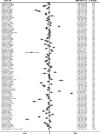Circulating adiponectin levels in various malignancies: an updated meta-analysis of 107 studies
- PMID: 27119501
- PMCID: PMC5217047
- DOI: 10.18632/oncotarget.8932
Circulating adiponectin levels in various malignancies: an updated meta-analysis of 107 studies
Abstract
Early detection of cancers is challenging for lack of specific biomarkers. Adiponectin is an adipokine predominantly derived from adipocytes and hypoadiponectinemia has been reported to associate with risk of many types of cancers. However, available evidence is controversial. Some studies show that increased adiponectin levels correlate with cancer risk. Therefore, we performed a meta-analysis of the association between circulating adiponectin levels and cancer development. A systematic search of PubMed, EMBASE, Wiley Online Library and Cochrane Library was conducted for eligible studies involving circulating adiponectin and malignancies from inception to August 8, 2015. Standard mean differences (SMDs) with 95% confidence intervals (95% CIs) were calculated by use of a random-effect model. Funnel plot and Egger's linear regression test were conducted to examine the risk of publication bias. 107 studies were included with 19,319 cases and 25,675 controls. The pooled analysis indicated that circulating adiponectin levels were lower in patients with various cancers than in controls, with a pooled SMD of -0.334 μg/ml (95% CI, -0.465 to -0.203, P = 0.000). No evidence of publication bias was observed. Circulating high molecular weight adiponectin levels were also lower in cancer patients than in controls, with a pooled SMD of -0.502 μg/ml (95% CI, -0.957 to -0.047, P = 0.000). This meta-analysis provides further evidence that decreased adiponectin levels is associated with risk of various cancers. Hypoadiponectinemia may represent a useful biomarker for early detection of cancers.
Keywords: adiponectin; biomarker; diagnosis; malignancy; meta-analysis.
Conflict of interest statement
The authors have no relevant affiliations or financial involvement with any organization or entity with a financial conflict with any materials discussed in the paper. All authors declare that there is no conflict of interest regarding the publication of this work.
Figures





Similar articles
-
Circulating visfatin levels and cancers risk: A systematic review and meta-analysis.J Cell Physiol. 2019 Apr;234(4):5011-5022. doi: 10.1002/jcp.27302. Epub 2018 Nov 23. J Cell Physiol. 2019. PMID: 30471099
-
The role of circulating adiponectin in prostate cancer: a meta-analysis.Int J Biol Markers. 2015 Feb 24;30(1):e22-31. doi: 10.5301/jbm.5000124. Int J Biol Markers. 2015. PMID: 25450645
-
Circulating adiponectin and risk of endometrial cancer.PLoS One. 2015 Jun 1;10(6):e0129824. doi: 10.1371/journal.pone.0129824. eCollection 2015. PLoS One. 2015. PMID: 26030130 Free PMC article.
-
Adiponectin levels and risk of coronary heart disease: a meta-analysis of prospective studies.Am J Med Sci. 2013 Jun;345(6):455-61. doi: 10.1097/MAJ.0b013e318262dbef. Am J Med Sci. 2013. PMID: 23123561
-
Importance of circulating adipocytokines in multiple myeloma: a systematic review and meta-analysis based on case-control studies.BMC Endocr Disord. 2022 Jan 25;22(1):29. doi: 10.1186/s12902-022-00939-2. BMC Endocr Disord. 2022. PMID: 35073877 Free PMC article.
Cited by
-
The Association of Pre-diagnostic Inflammatory Markers and Adipokines and the Risk of Non-Hodgkin Lymphoma Development in Egypt.Indian J Hematol Blood Transfus. 2021 Jan;37(1):76-81. doi: 10.1007/s12288-020-01305-9. Epub 2020 Jun 19. Indian J Hematol Blood Transfus. 2021. PMID: 33707838 Free PMC article.
-
Intermittent and periodic fasting, longevity and disease.Nat Aging. 2021 Jan;1(1):47-59. doi: 10.1038/s43587-020-00013-3. Epub 2021 Jan 14. Nat Aging. 2021. PMID: 35310455 Free PMC article.
-
Mechanistic Insights into the Link between Obesity and Prostate Cancer.Int J Mol Sci. 2021 Apr 11;22(8):3935. doi: 10.3390/ijms22083935. Int J Mol Sci. 2021. PMID: 33920379 Free PMC article. Review.
-
The bifurcated role of adiponectin in colorectal cancer.Life Sci. 2021 Aug 1;278:119524. doi: 10.1016/j.lfs.2021.119524. Epub 2021 Apr 19. Life Sci. 2021. PMID: 33887344 Free PMC article. Review.
-
The role of bidirectional communication between the adipokines and the endogenous opioid system in an experimental mouse model of colitis-associated colorectal cancer.Pharmacol Rep. 2024 Feb;76(1):112-126. doi: 10.1007/s43440-023-00566-1. Epub 2024 Jan 18. Pharmacol Rep. 2024. PMID: 38236555
References
-
- Bray F, Ren JS, Masuyer E, Ferlay J. Global estimates of cancer prevalence for 27 sites in the adult population in 2008. Int J Cancer. 2013;132:1133–1145. - PubMed
-
- Kelly T, Yang W, Chen CS, Reynolds K, He J. Global burden of obesity in 2005 and projections to 2030. Int J Obes (Lond) 2008;32:1431–1437. - PubMed
-
- Calle EE, Kaaks R. Overweight, obesity and cancer: epidemiological evidence and proposed mechanisms. Nat Rev Cancer. 2004;4:579–591. - PubMed
-
- Trevellin E, Scarpa M, Carraro A, Lunardi F, Kotsafti A, Porzionato A, Saadeh L, Cagol M, Alfieri R, Tedeschi U, Calabrese F, Castoro C, Vettor R. Esophageal adenocarcinoma and obesity: peritumoral adipose tissue plays a role in lymph node invasion. Oncotarget. 2015;6:11203–11215. doi: 10.18632/oncotarget.3587. - DOI - PMC - PubMed
-
- Scherer PE, Williams S, Fogliano M, Baldini G, Lodish HF. A novel serum protein similar to C1q, produced exclusively in adipocytes. J Biol Chem. 1995;270:26746–26749. - PubMed
Publication types
MeSH terms
Substances
Supplementary concepts
LinkOut - more resources
Full Text Sources
Other Literature Sources
Miscellaneous

